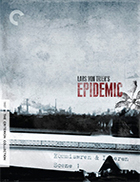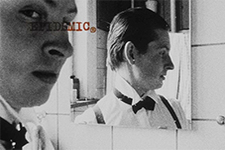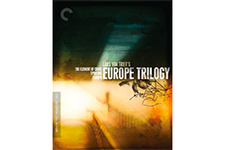| Director: Lars von Trier | | Screenplay: Lars von Trier & Niels Vørsel | | Stars: Lars von Trier (Lars / Dr. Mesmer), Niels Vørsel (Niels), Claes Kastholm Hansen (Claes), Susanne Ottesen (Susanne), Jørgen Christian Krüff (Sommelier), Cæcilia Holbek (Nurse), Leif Magnusson (Doctor), Olaf Ussing (Doctor), Ole Ernst (Doctor), Udo Kier (Udo) | | MPAA Rating: NR | | Year of Release: 1987 | | Country: Denmark |  |
|  Lars von Trier’s Epidemic was a major step backward from his debut feature, The Element of Crime (Forbrydelsens element, 1984). Long, ponderous, amateurish, and remarkably dull, it seeks to be some kind of self-aware hybrid of reflexive meta-film about the film industry and a drama about a rampaging virus. Where The Element of Crime was visually marvelous and audacious, Epidemic is exceedingly ugly to watch, filled with sloppy framing and awkward zooms, the kind of crude cinematography that is usually justified as being “documentary-like” but here just feels lazy (the fact that von Trier mixes in long, complex tracking shots from time to time makes the bad shots feel that much worse). And let’s not even talk about the inexplicable decision to leave the film’s title in translucent red lettering in the upper lefthand corner of the frame for most the film’s running time. Not surprisingly, Epidemic was rejected by audiences and has, until now, been difficult to see, even though von Trier, in one of his numerous bouts of pointless provocation, has declared it his best film. The slapdash, pseudo-vèrité look derives partially from intentional budget limitations. Epidemic emerged out of a bet between von Trier and Claes Kastholm Hansen, a consultant at Dansk Filminstituet (the Danish Film Institute), about whether von Trier could make a feature film from one million Danish kroner. That would have been about $150,000 in 1987, the equivalent of roughly $385,000 today, which doesn’t strike me as an exceedingly low budget given the film’s relatively meager ambitions. Von Trier also saved money by casting himself and his co-screenwriter Niels Vørsel (with whom he had collaborated on The Element of Crime) as fictionalized versions of themselves, a director and screenwriter who have written a script called The Cop and the Whore (an allusion to their previous film, which prominently featured a police officer and a prostitute). They have spent the previous 18 months working on the script, but it mysteriously disappears from their computer, forcing them to come up with a new script in less than two weeks because they can’t remember anything about the earlier one. And what do they come up with? Would you believe a script for a movie called Epidemic? And would you believe that it features an epidemiologist named Dr. Mesmer (also played by von Trier) who is futilely trying to stop a plague from spreading through a European city and that a later scene in the film features hypnosis? The narrative thus pinballs back and forth between the mundane reality of Lars and Niels working on the script (which is shot in extra-grainy 16mm) and scenes from the movie they are writing (shot in smooth 35mm), although there are intimations that perhaps the two worlds are not reality and fiction, but some kind of hybrid in which the latter is oozing into the former (or vice-versa—who knows?). The scenes with Lars and Niels are mostly insufferable, as their characters are uninteresting cads who do little more than smoke and drink and talk. Most of these interactions were improvised, and it feels that way. At one point Niels goes on about how he wanted to learn about America through letters with Americans, so he posed as a 16-year-old student and became pen pals with a number of American teenage girls, whose responses to his letters he mocks and chides to Lars. It is a long scene without much relevance to anything, although it does point toward von Trier’s future of making films about America without having ever set foot in the country. The scenes of the film-within-the-film are generally better, particularly a complex tracking shot in an underground city featuring various scientists and military officials debating how to combat the rampaging virus, which is all the more interesting to watch post-COVID. And the film’s final scene is delightfully bizarre, giving us a hysterical case of hypnotism-gone-wrong that brings to the fore the graphic horrors that had been promised, but largely left off-screen up until that point. It is telling, though, that the film improves only when people start vomiting blood. | Epidemic Criterion Collection Blu-ray |  Epidemic is available as part of Criterion’s three-disc set “Lars von Trier’s Europe Trilogy,” which also includes The Element of Crime and Europa. Epidemic is available as part of Criterion’s three-disc set “Lars von Trier’s Europe Trilogy,” which also includes The Element of Crime and Europa. | | Aspect Ratio | 1.89:1 (Element of Crime)
1.66:1 (Epidemic)
2.39:1 (Europa) | | Audio | English Linear PCM 1.0 monaural (The Element of Crime)Danish Linear PCM 1.0 monaural (Epidemic)English/German Linear PCM 2.0 stereo (Europa) | | Subtitles | English | | Supplements | Audio commentary on The Element of Crime by director Lars von Trier, film and sound editor Tomas Gislason, and cinematographer Tom EllingAudio commentary on The Element of Crime by film scholar Peter Schepelern and filmmaker and critic Stig BjorkmanAudio commentary on Epidemci by von Trier and screenwriter and actor Niels VorselAudio commentary on Europa by von Trier and producer Peter Aalbwk JensenSelected-scene audio commentary on Europa by von Trier and actors Jean-Marc Barr and Udo KierTranceformer: A Portrait of Lars von Trier (1997) documentary by Stig Björkman“Storyboarding The Element of Crime” featurette“Anecdotes From The Element of Crime” featuretteInterview from 2005 with von Trier about the Europe TrilogyMaking-of documentaries for all three filmsPrograms on the films featuring interviews with many of von Trier’s collaboratorsTwo short student films by von Trier: Nocturne (1980) and Images of Liberation (1982) Danish television interview with von Trier from 1994“Portrait of Lars Von Trier” featurette “Anecdotes From Epidemic” featurette“From Dreyer to Von Trier” featurette“Anecdotes From Europa” featurette“Lars von Trier Anecdotes” featurette“The Emotional Music Script for Europa” featurette“A Conversation with Lars Von Trier” featurette”Trier’s Element” featuretteTrailersEssay by critic Howard Hampton | | Distributor | The Criterion Collection | | Release Date | January 17, 2023 | | | COMMENTS | | All three films in the “Europe Trilogy” have been newly scanned and restored. The Element of Crime and Epidemic were both scanned in 3K from the original 16mm camera negatives, while Europa was scanned in 4K from its original 35mm camera negative. Restoration work was carried out by Zentropa and approved by Lars von Trier. The transfer of The Element of Crime highlights with stunning clarity and great detail the film’s complex visual structure. As it is similar to a black-and-white film, the main challenge to the transfer was the contrast and black levels, both of which are mostly dead-on. Von Trier constantly infuses the frame with a great deal of hard contrast in the form of lights cutting through the darkness, and the transfer handles all of these scenes very well. The contrast between the sepia tones and the electronic bluish hues are also well-rendered. Epidemic is, simply put, an ugly movie, so even though the transfer is spot on, it still doesn’t look very good. The 16mm portions of the film are extremely grainy with a great deal of noise and hard contrast that makes parts of the image murky and other parts blown out, which is the intended look (or at least how it looked theatrically). The scenes shot on 35mm look much better, with a smoother sheen and good detail. The challenge with Europa is that virtually every shot in the film is an optical and is thus at best a copy of a copy. This results in the film having a slightly soft appearance, although it is sharp enough to make out plenty of detail in the often astounding visuals. The black-and-white image has good contrast and a nice range of grayscale, while the moments of color are appropriately desaturated and slightly unnatural. There is no information in the liner notes about the sources for the soundtracks. The Element of Crime and Epidemic are both in monaural while Europa is in stereo. The only film that sounds a bit problematic is Epidemic, which features quite a bit of aural hiss, but that is surely inherent to the low-budget film’s original soundtrack (and probably intentional). As far as supplements go, make sure you block out about a week of your life if you want to get through it all. Criterion has assembled a massive array of extras, most of which have been drawn from previous releases. We can start with the audio commentaries, of which there are five spread across the three films and all of which were recorded in 2005: The Element of Crime gets two, one from director Lars von Trier, film and sound editor Tomas Gislason, and cinematographer Tom Elling and one by film scholar Peter Schepelern, a professor at the University of Copenhagen, and filmmaker and critic Stig Bjorkman; Epidemic gets one by von Trier and screenwriter/actor Niels Vørsel; and Europa gets two, one by von Trier and producer Peter Aalbwk Jensen and then a selected-scene commentary by von Trier and actors Jean-Marc Barr and Udo Kier. Each of the discs is packed with additional supplements, most of which relate to that particular film, but others of which are more generally about von Trier and his work. On the Element of Crime disc we get Tranceformer: A Portrait of Lars von Trier, an excellent 1997 documentary by Stig Björkman that runs 54 minutes. Conveniently broken up into 10 chapters, it is a fine overview of von Trier’s complex and already controversial career. It includes extensive interviews with von Trier and his filmmaking associates, as well as footage of 8mm and 16mm films he made as a child and his work as a film student. (One complaint: The documentary does not use screen titles to note who the interviewees are, so you have to figure out who they are from the context of their statements.) The documentary covers both von Trier’s early work on his “Europe Trilogy” in the 1980s and his later output in the 1990s (with special emphasis on Breaking the Waves), concentrating on his consistent themes and his renown as a controversial director. “Storyboarding The Element of Crime” is an 11-minute interview from 2005 with cinematographer Tom Elling about how he and von Trier storyboarded the film. A 30-minute behind-the-scenes documentary from 1984 includes footage of the film in production and interviews with von Trier, actors Michael Elphick and MeMe Lai, and executive producer Per Hoist, among others. “Anecdotes From The Element of Crime” is a 20-minute featurette from 2005 that includes interviews with film scholar Peter Schepelern, film and sound editor Tomas Gislason, assistant director Ake Sandgren, executive producer Per Hoist, prop master Peter Grant, production manager Per Arman, gaffer Birger Larsen, and sound recordist Henrik Fleischer. Finally, the disc includes a trailer and two of the films von Trier made while he was studying at the National Film School of Denmark: the experimental Nocturne (1980) and Images of Liberation (1982), a drama about a German officer and his Danish mistress in the final days of World War II. The Epidemic disc opens with “Portrait of Lars von Trier,” a 1991 interview he gave for Danish teleivison. The 17-minute featurette “Anecdotes From Epidemic” includes interviews with screenwriter and actor Niels Vorsel, cinematographer Kristoffer Nyholm, actors Udo Kier and Michael Simpson, film scholar Peter Schepelern, and film consultant Claes Kastholm Hansen. The 150-minute featurette “From Dreyer to Von Trier” consists of an interview with cinematographer Henning Bendtsen, who, as the title suggests, began he career working with Carl Theodor Dreyer and ended with several of von Trier’s films (his second-to-last film was Europa. The disc also includes a very short trailer. The Europa disc starts with “The Making of Europa,” a 40-minute documentary produced in 1991 about the film’s production. Despite the rather shoddy video quality, the doc presents a fascinating journey from the elaborate process of storyboarding to the various stages of production, including behind-the-scenes footage on location and on the set and several interviews with von Trier. “Triers Element” is another 1991 documentary about the film’s production, although this one dedicates significantly more time to an interview with von Trier, and it also includes footage from the production of Dimension, a film von Trier started shooting in 1991 and plans to work on for three decades. “Anecdotes From Europa, a 20-minute documentary from 2005, is exactly what it sounds like: amusing anecdotes about the film’s production told by film historian Peter Schepelern, actor Jean-Marc Barr, producer Peter Aalbæk Jensen, assistant director Tómas Gislason, co-writer Niels Vørsel, and prop master Peter Grant (the best involve Jensen illegally bringing guns into Poland for the shoot and bribing notoriously difficult actor Ernst-Hugo Järegård with Cuban cigars). Also from 2005 are a series of video interviews with cinematographer Henning Bendtsen, composer Joachim Holbek, costume designer Manon Rasmussen, film-school teacher Mogens Rukov, editor Tómas Gislason, producer Peter Aalbæk Jensen, art director Peter Grant, actor Michael Simpson, production manager Per Arman, and actor Ole Ernst. There is also another 43-minute interview with von Trier recorded in 2005 in which he speaks extensively about the “Europe Trilogy.” Lastly, “The Emotional Music Script for Europa” is a 12-minute interview with composer Joachim Holbek. |
Copyright © 2023 James Kendrick Thoughts? E-mail James Kendrick All images copyright © The Criterion Collection |


 (1.5)
(1.5)

 Epidemic is available as part of Criterion’s three-disc set “Lars von Trier’s Europe Trilogy,” which also includes The Element of Crime and Europa.
Epidemic is available as part of Criterion’s three-disc set “Lars von Trier’s Europe Trilogy,” which also includes The Element of Crime and Europa.